Protecting a Forest and Preserving a Culture
Air Date: Week of December 4, 2009
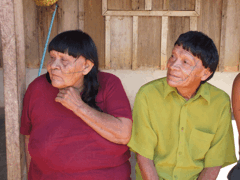
Chief Almir’s parents are the last generation with traditional tribal tattoos. The tradition ended after first contact with white settlers in 1969. (Photo: Bobby Bascomb)
In Brazil’s Southwest Amazon region, an ancient tribe turns to modern technology to save their forest, culture, and perhaps the planet’s climate. The Surui people have preserved their forest for millennia. Now they’ve devised a new management plan to protect it in the future. It calls for reforesting 18,000 acres cut by loggers and planting 1 million trees. Bruce Gellerman and Bobby Bascomb travel to the Surui reserve to see the tribe’s re-forestry project in action.
Transcript
CURWOOD: It’s Living on Earth. I’m Steve Curwood. The last stop on our REDD Path to a Green Planet takes Bruce Gellerman and Bobby Bascomb to a remote corner of the Amazon in Surui territory. The Surui are an ancient indigenous people who are pioneering a new forest management plan. It’s designed to rescue their culture, preserve their forest, and perhaps, just perhaps, help save the planet from catastrophic climate disruption.
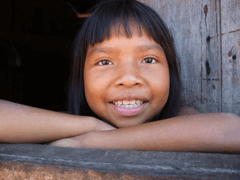
After first contact with white settlers on September 7th, 1969, ninety percent of the Surui died from diseases. Today there are 1,300 members of the Surui living in 4 clans. (Photo: Bruce Gellerman)
[UNFOLDING MAP]
BASCOMB: Chief Almir Surui carefully unfolds a map and spreads it on a table. The Surui have been living here in the southwest Amazon for thousands of years, yet this map of their homeland is the first of its kind.
ALMIR: [Translation] If you look at every single spot, every single creek. What we did here is simply understand deep inside our wealth. Our people know what we have.
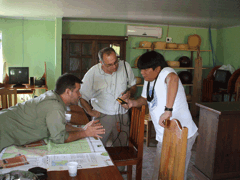
Chief Almir demonstrates the Surui’s GPS units to Bruce Gellerman and guide Marco Lima. (Photo: Bobby Bascomb)
GELLERMAN: The map shows where the Surui harvest cashews and other foods from the forest. And tiny symbols mark sites where shamans performed rituals and the Surui fought historic battles.
GELLERMAN: What is this, it looks like little huts.
ALMIR: [Translation] Powantigua is the place where was made the contact with the Surui people.
GELLERMAN: First contact with the Surui was September 7th 1969. That’s the day Brazilian government agents first approached the tribe. Settlers soon followed, stealing 80 percent of the Surui land and bringing new diseases that killed 90 percent of the people.
[MAP UNFOLDING SOUNDS]
BASCOMB: Today, the Surui are fighting back. We’re in the Surui business office in the small town of Cacoal. On a wall hangs a bow and arrow and a long, sharp spear.
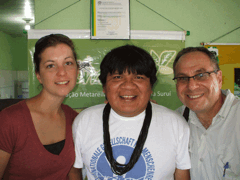
Bobby Bascomb, Almir Surui and Bruce Gellerman in the Surui business office in Cacoal, state of Rondonia, Brazil. (Photo: Marco Lima)
[TYPING ON COMPUTER]
BASCOMB: And on a conference table: a laptop. The Surui are now defending their land with computers, GPS units, and satellite images donated by the U.S.-based Amazon Conservation Team. The Surui used the technology to create this detailed map of their reserve.
ALMIR: [Translation] I'm going to show you now how we want to use technology to protect our territory.
[CLICKING SOUNDS ON COMPUTER]
BASCOMB: So, right now you’re using laptop to zoom in on – is that your house right there?
ALMIR: [Translation] Here you can see how much deforestation we have and also above here you can see the other indigenous territory. All the whites you can see, all the white spots, these are farms that have already destroyed the forest.
BASCOMB: To preserve what’s left of the forest and replant what’s been lost to settlers, Chief Almir has devised a 50-year management plan. It’s a pioneering Indigenous REDD project. The Surui hope to profit by protecting their 600 thousand acre forest and auction off the carbon stored in the trees.
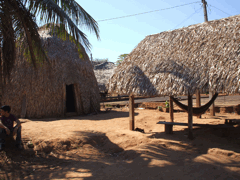
Except for the telephone pole this could have been a scene of a Surui village 1,000 years ago. (Photo: Bruce Gellerman)
GELLERMAN: They plan to sell the forest carbon as credits to companies and countries that want to offset their climate disrupting emissions. To verify their carbon inventory, the tribe uses images from orbiting satellites. In just two generations, the Surui have gone from the Stone Age to the Space Age.
GELLERMAN: You know it’s given you a whole different viewpoint on the world. When you show this to the people of your tribe – when you show these satellite pictures – what do they say?
ALMIR: [Translation] We thought that these images were something like coming from the eye of a monster who likes to eat forest, then we thought, well, maybe we can use the eyes of this monster to protect the forest.
[ROAD SOUNDS]
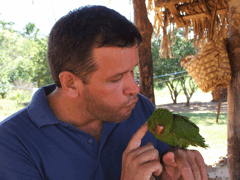
Translator, Marco Lima, speaks parrot with a fine feathered friend. (Photo: Bobby Bascomb)
BASCOMB: It’s 25 bone-jarring miles from Chief Almir ’s office to the Surui tribal village. Our guide, Marco, drives while we bounce around in the back. Almir sits in front.
GELLERMAN: We travel past fields that have been slashed for their hardwood and burned to make way for cattle ranches and soy farms. All that remains of what was once a dense rainforest are knee-high tree stumps, and bitter memories of first contact.
ALMIR: [Translation] We had to give up on our land to survive, to remain alive. I’m not against farms; I’m not against production. The only thing I’m really concerned that the white man should see is that they have to grow with sustainable responsibility.
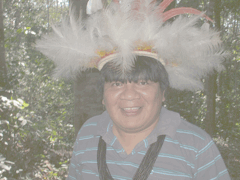
Chief Almir wearing a traditional Surui feather head dress and beads (Photo: Bruce Gellerman)
GELLERMAN: When you see this does it make your angry? Does it make you…?
ALMIR: [Translation] I get first of all sad because I really don’t know what happened to a guy like this who simply comes in and clears everything. I don’t know what goes on in his brain.
LIMA: Now we are we getting to the Surui people and as you can see the amazing difference of the vegetation of what you can see over there and what is in here – there you can see the cattle and over there you can see pristine forest.
GELLERMAN: The difference couldn’t be more dramatic: deforestation ends where Surui territory begins. Like a surgeon’s knife, the chain saws of illegal loggers have cut clean, separating dense Surui forest reserve from open farmland.
GELLERMAN: At a sharp bend in the road we see loggers leaning on dirt motorbikes and they see us. We get cold hard stares. I want to stop and talk to the loggers.
BASCOMB: But Almir says, oh, no, no, no. Keep going.
ALMIR: [Translation] Let's not stop. Let’s not stop. They’ll give us a hard time.
GELLERMAN: Why's that?
ALMIR: [Translation] They threat us because all this logging here is illegal. I was threatened so many times here.
BASCOMB: Really?
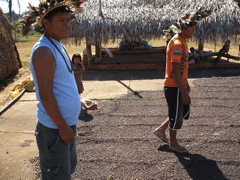
Surui teens spread coffee beans to dry in the sun. (Photo: Bruce Gellerman)
ALMIR: [Translation] It’s very dangerous.
BASCOMB: Over the past decade 11 tribal elders in the Amazon have been assassinated. Two were Surui. It was almost three: a few years ago someone tried to run Almir off this road. He was evacuated out of Brazil, and when he returned he was promised protection, but Almir says, that was a joke.
ALMIR: [Translation] The secret security they were supposed to take care of me it so secret that I’ve never seen it. [Laughs]
[TRUCK STOPS]
GELLERMAN: That’s quite a trip.
BASCOMB: Wasn’t as long as I’d thought it’d be.
GELLERMAN: We finally arrive at the Surui village. It’s a scattering of wood huts with palm-thatched roofs. The Surui sleep in rope hammocks and use wood to cook in open fire pits.
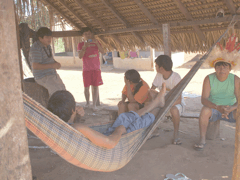
Surui men hang out in hammocks to escape the hot tropical sun. (Photo: Bruce Gellerman)
[VILLAGE AMBIENCE]
GELLERMAN: Bon jia…
GELLERMAN: Next to a vegetable garden are solar panels and where coffee beans dry: a satellite dish.
ALMIR: [Translation] Here is our tribe. And here you have my father my mother, my nephews, my brothers.
BASCOMB: The Surui have extended families, and elders are revered. Almir proudly introduces us to his father, the former chief of the tribe.
ALMIR: Marco, Brucy, Bobby.
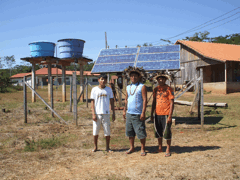
Surui teens show off the tribe’s solar panels. (Photo: Bruce Gellerman)
FATHER: Marco, eh?
ALMIR: Marco.
GELLERMAN: Bruce.
LIMA: Brucee…Bobby.
BASCOMB: Moto Brasie.
LIMA: He says his name is Marimope.
BASCOMB: Chief Marimope’s face is lined with tribal tattoos. His son, Chief Almir has none. The custom ended 40 years ago, after first contact with white settlers. Surui chiefs can have up to four wives. So far, Almir has two. He is the critical link bridging the tribe’s past with it’s future. Chief Almir is the first of the Surui to attend college. Still, tradition and lore guide his way.
ALMIR: [Translation] My father told us so many times about how he grabbed his bow and arrow and went to war.
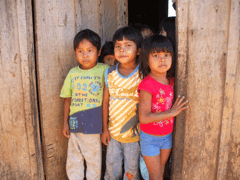
Curious children peek at us from their homes. (Photo: Bruce Gellerman)
GELLERMAN: Almir proudly retells the story of a time his father Chief Marimope defended the forest. Settlers had invaded Surui land and cut down their trees. Chief Marimope blocked the logging trucks.
[ALMIR SPEAKING PORTUGUESE]
GELLERMAN: When 200 Brazilian soldiers returned to claim the trucks and trees they surrounded the Surui. But Chief Marimope stood his ground.
ALMIR: [Translation] And he said to the commander, “Commander, I can even be killed, but you will die before I die.”
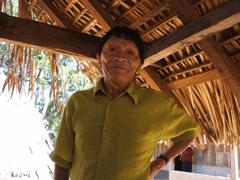
Chief Marimope is a legendary Surui warrior. He once stood his ground against 200 Brazilian soldiers who came to the tribe’s reserve to take logs cut from Surui land. (Photo: Bruce Gellerman)
ALMIR: [Translation] But you are the one that’s going to decide. You have family I also have family. Your family will be without you; my family will be without me. And my sister was translating for him – she was just a teenager, as you know my father doesn’t speak Portuguese. And the commander was like walking backwards, and then he fell on the ground. And then my father pointed bow and arrow to him and said, “Throw your gun away.” He said this commander said, “Okay, I’m sorry, friend, I apologize.” And father said, “No, no, no, friends don’t act like this to other friends; get out of here, get out of my place.” And the commander said to all his men, “for god sake don’t do anything to these guys, let’s get out of here.”
[CHOPPING SOUNDS]
GELLERMAN: The forest is sacred to the Surui. It’s essential for their existence and subsistence. The forest provides.
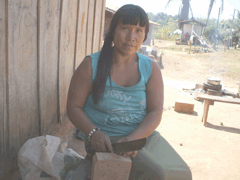
The forest provides: a young Surui woman chops nuts. They yield worms to eat and decorative jewelery. (Photo: Bruce Gellerman)
[CHOPPING SOUNDS CONTINUE]
GELLERMAN: A young woman sits on a low wood stool and with quick, sharp blows from her machete, cracks open nuts she’s gathered from the forest, saving the shells and what’s inside.
GELLERMAN: Oh my god, there’s worms. WORMS!
[WOMAN LAUGHS]
GELLERMAN: Hey, Bobby…take a close look at what she’s doing.
BASCOMB: Oh, those aren’t nuts, those are worms. What are they for? Are those for lunch? Para desauno, para comida?
WOMAN: Comida.
GELLERMAN: And then she’s cutting the shell, watch. She’s cuts the shell. Yeah, she’s cutting the beads, yeah, she’s making beads.
[CHOPPING SOUNDS]
BASCOMB: Ahhh.
[GRASS CRUNCHING; WALKING SOUNDS]
BASCOMB: It’s a short hike to the forest where the Surui gather these nuts. As we walk Chief Almir details his 50-year management plan. The tribe will continue to protect the forest as they’ve always done, and replant 18 thousand acres of trees illegal loggers cut down on Surui territory.
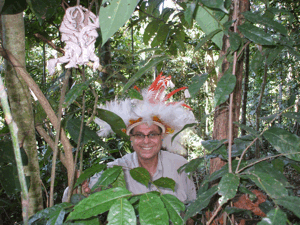
The surui were amused when Bruce tried on a traditional headdress. (Photo: Almir Surui)
GELLERMAN: All told, the tribe plans to grow a million new trees. So far, they’ve planted 80 thousand.
ALMIR: [Translation] I think what we should do is make this a forest again. Let area receive species that always belonged to here. Feel the air, smell this, so delicious.
[SOUNDS OF BREATHING AIR IN]
ALMIR: Not only through nose, but don’t you feel skin breathing?
GELLERMAN: Can you restore the forest to the condition that it was before it was destroyed?
ALMIR: [Translation] Yes, we definitely can. That’s why we are researching areas that are today pasture so we can through science understand what kind of species used to live here. And then we can apply to every area according to its needs.
[WALKING NOISES; ALMIR SPEAKING PORTUGUESE]

Chief Almir’s parents are the last generation with tribal tattoos. The tradition ended after first contact with white settlers in 1969. (Photo: Bobby Bascomb)
ALMIR: [Translation] This is a result of re-forestry already. This is also hardwood – mahogano – Brazilian cherry.
BASCOMB: Yeah, how did you choose these trees? Why these trees and not some other kind?
ALMIR: [Translation] The way we thought and planned was let’s replant the trees that suffered bigger impact. And we also choose fruit trees that can feed our people. And we also picked trees that have the importance on our rituals, things that really make a difference for our culture.
[WALKING NOISES]
ALMIR: [Translation] This plant was identified by the researchers. This is a medicinal plant – it is a very good anesthesiac for a toothache. We chew the leaf.
GELLERMAN: Hmmm. It’s a mint. Ah, it’s numbing. My tongue is totally numb. [Laughs]
ALMIR: This very good for toothaches and also for ant bites.
BASCOMB: Have you ever considered to market these?
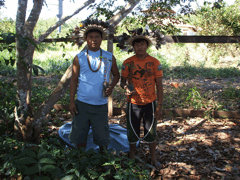
Surui teens hold seedlings for the reforestry project. (Photo: Bruce Gellerman)
ALMIR: [Translation] Yes, our main idea is to make use of the forest the way it is. Keeping it. Preserving it. Respecting the forest, using the forest the way it, first of all, is going to remain preserved, and then of course in a way it can also benefit not only us, but also the rest of the world.
[BIRD SOUNDS]
GELLERMAN: What is that?
ALMIR: [Translation] “Ah….they are coming,” that’s what they are saying.
[BIRD SOUNDS CONTINUE]
GELLERMAN: The Surui say when the Akaki bird’s sings it’s warning: that there are other people in the forest watching them. But Almir doesn’t need the Akaki to warn him. He knows he’s being watched by illegal loggers. But he has work to do in town. So he has us take a different road back so he can avoid their threatening stares.
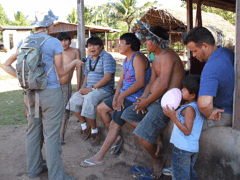
Bobby Bascomb interviews Chief Almir as he sits with his family (Photo: Bruce Gellerman)
[ROAD SOUNDS]
BASCOMB: To make sure their forest carbon deals are air tight, the Surui tribe has retained one of the world’s largest law firms, and Chief Almir has called upon Ivaneide Cardozo to ensure the REDD deal doesn’t turn into green washing. She is one of Almir’s two wives, and head of an NGO that helps indigenous people defend their land.
CARDOZO: [Translation] For the past three years we’ve been preparing a whole tribe the whole community to have a project and sell it.
[CARDOZE SPEAKING PORTUGUESE]
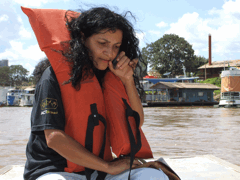
Ivaneide Cardozo is head of Kaninde, an indigenous environmental NGO. She is one of Chief Almir’s two wives and works on the Surui REDD project. (Photo: Bruce Gellerman)
CARDOZO: [Translation] The point is, are we going to sell to any company? We don’t want that. What we want to sell these rights to companies that want to protect the environment. Are we going to wash the faces of dirty companies? No. We’re not here only to sell, we are here to negotiate with people that are committed to the environment.
[CHIEF ALMIR’S MOTHER SPEAKING SURUI]
MOTHER: [Translation] I think it’s good for people from the outside to help repair this destroyed forest.
BASCOMB: That’s Chief Almir’s mother. She survived the diseases of first contact and endured the threats from illegal loggers. Now she puts her hopes in her son’s REDD forest project.
MOTHER: [Translation] It’s like we are giving, but also receiving. We do reforestry and this service will help mankind breathe better. I think help from international institutions is very important to Almir’s efforts. This needs to be a model for other indigenous groups and institutions.
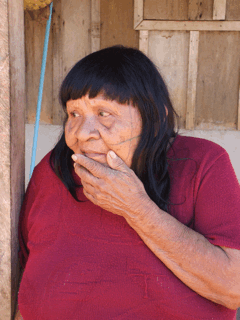
Elders like Chief Almir’s mother only speak their traditional language, Paite. They never learned to Portuguese, the language of the settlers. (Photo: Bobby Bascomb)
GELLERMAN: Indigenous people comprise less than three percent of Brazil’s population yet they control and protect a quarter of the Amazon forest. It’s the largest tropical forest left on the planet.
[VOICES TALKING; VILLAGE SOUNDS]
GELLERMAN: Almir, it seems to me, it just struck me – that what you’re doing here in this village in Brazil could change the world.
ALMIR: [Translation] What I need to do is try to make a better world. I don’t want to just be proud of it; I want to be contagious and have all other people coming with me, beside me, with the same idea. And bring to the world the hope of a new reality.
[BIRD SOUNDS]
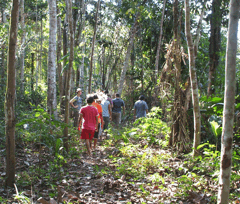
The Surui say that the Acaci bird warns of intruders in the forest. (Photo: Bruce Gellerman)
GELLERMAN: For a month, we traveled the reality that is today’s Amazon in search of how REDD might work. We drove five thousand miles over unpaved roads bulldozed through what’s left of the forest. We met politicians and environmentalists, cattle ranchers and farmers, indigenous people and scientists – all who seem to have the same good intentions: sustaining the forest while developing it. But REDD is an unproven method that will cost hundreds of billions of dollars, require complex systems to monitor. And if REDD is to work, and help stall climate disruption, it will also take a global society that appreciates just what’s at stake – and finds the will to act.
[BIRD SOUNDS]
BASCOMB: And high in the canopy of Brazil’s Amazon forest the Akaki bird watches and warns: time is running out.
[BIRD SOUNDS CONTINUE]
[MUSIC: Baden Powell “Estorias De Alcantara” from ‘Baden Powell: Three Originals’ (MPS Records - 1975)]
CURWOOD: Our story about Brazil’s Amazon was produced by Living on Earth’s Bruce Gellerman and Bobby Bascomb, with help from Marco Lima. It’s part of our ongoing series, REDD path to Green Planet. Next week, we travel to Copenhagen and report on the climate summit and visit Indonesia’s tropical forest to see how REDD could work there.
Links
Ivaneide Cardozo's NGO Kaninde works with the Surui on the REDD forest project
Living on Earth wants to hear from you!
Living on Earth
62 Calef Highway, Suite 212
Lee, NH 03861
Telephone: 617-287-4121
E-mail: comments@loe.org
Newsletter [Click here]
Donate to Living on Earth!
Living on Earth is an independent media program and relies entirely on contributions from listeners and institutions supporting public service. Please donate now to preserve an independent environmental voice.
NewsletterLiving on Earth offers a weekly delivery of the show's rundown to your mailbox. Sign up for our newsletter today!
 Sailors For The Sea: Be the change you want to sea.
Sailors For The Sea: Be the change you want to sea.
 The Grantham Foundation for the Protection of the Environment: Committed to protecting and improving the health of the global environment.
The Grantham Foundation for the Protection of the Environment: Committed to protecting and improving the health of the global environment.
 Contribute to Living on Earth and receive, as our gift to you, an archival print of one of Mark Seth Lender's extraordinary wildlife photographs. Follow the link to see Mark's current collection of photographs.
Contribute to Living on Earth and receive, as our gift to you, an archival print of one of Mark Seth Lender's extraordinary wildlife photographs. Follow the link to see Mark's current collection of photographs.
 Buy a signed copy of Mark Seth Lender's book Smeagull the Seagull & support Living on Earth
Buy a signed copy of Mark Seth Lender's book Smeagull the Seagull & support Living on Earth

